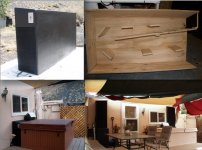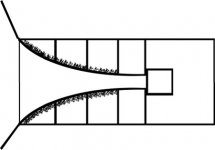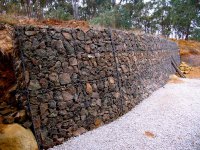--- not in contact with damp earth ---
I agree - you do not want to trap moisture under a shipping container for the long-term.
The best possible rust prevention for ordinary carbon steel, is a good coat of paint.
Stackable maritime shipping containers - specifically the ones that are stacked a dozen tall on cargo ships - are very tough, and very rigid units. They also have excellent door seals. I suspect they are quite expensive on the private market though. . .
Last edited:
For a sinewave the maximum acceleration is at crossover/midpoint of stroke.
That should mean that when current is max/peak, then the force is max and the cone will be at midstroke and crossing over.
Does that makes sense?
Not really. At midpoint, the cone is at maximum speed, and is neither accelerating or braking. Maximum acceleration is at the max and min of the sine wave.
looks like I got my max and min all mixed up !Not really. At midpoint, the cone is at maximum speed, and is neither accelerating or braking. Maximum acceleration is at the max and min of the sine wave.
if you fit 5 12" drivers to the five sides of a 15" cube, you can use the 6th side as your throat. That gives you a compression ratio ~2:1Yet again, I'm in full agreement. I'm still leaning towards (qty 5) 12" drivers per horn. If I build my horns with wooden rears, I can run a single 12 (extend the length & reduce the throat), or I can run a single 18, or I can make the throat large, and run several drivers. I want to be able to try different driver configurations - to see what sounds best - without having to take a jackhammer to my concrete. . . .
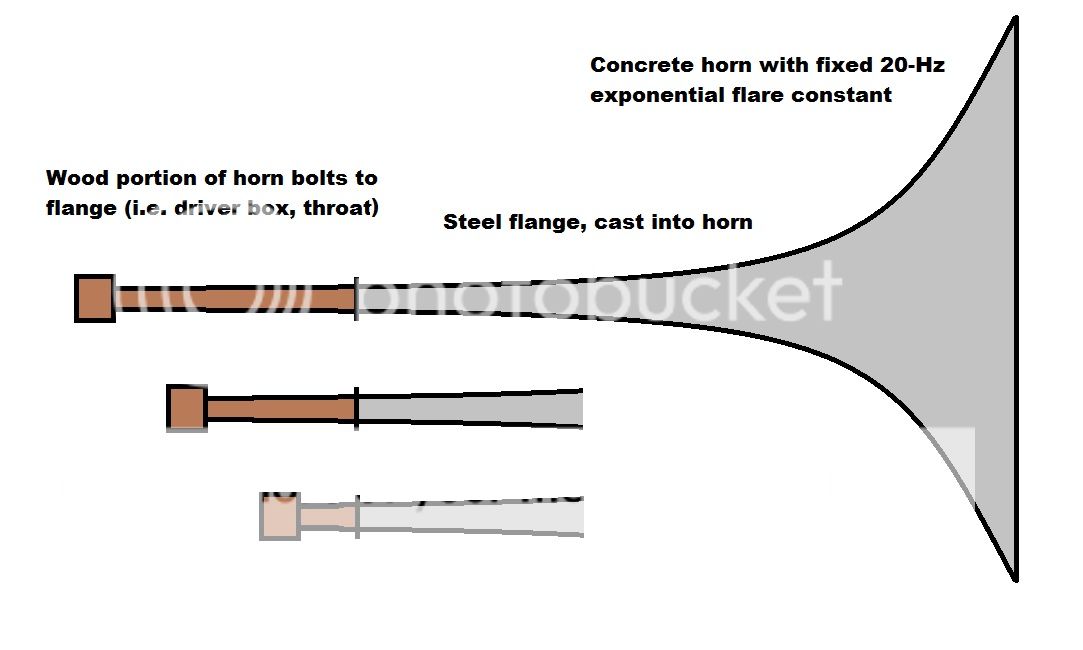
The square throat can fairly easily be attached to a square section horn.
You can make your wood transition pieces tapered to allow you to experiment with smaller throats, equals higher compression ratios. The same cube will simply bolt onto the flange of the transition piece.
Similarly you could use 5off 15" drivers in an 18" cube for a bigger Sd and bigger throat.
100W into each driver is not much and if your efficiency gets close to 50% your amplifier ends up driving a nearly resistive load that is 40% of the single driver impedance rather than driving only 20% which is much harder on the amplifier.
But you do have to roll off the sub-audio pretty steeply because the impedance will drop right down and the cone excursion will skyrocket if you try to push even gentle sub-audio frequencies. The 5drivers cannot benefit from the reactance of a sealed box around them. But they don't need that if you watch the frequencies relative to where the horn starts to unload.
Last edited:
Happy you realize you only need to make a half horn, and again on a practical way to make this:
http://www.sca.org.uk/pdf_word/Intro_to_Sprayed_Concrete.pdf
With fibre reinforcement, this is probably the only practical way to produce compound curves, which you will want to have for reasons of structural rigidity and also because a round (semi-round in this case) horn is best.
Cast a floor, build a mold for the inside on top of it (Styrofoam is great because you can easily work it e.g. cut it with a hot wire), spray it with concrete and remove the mold.
It might still take you the better part of a Saturday afternoon, though.
http://www.sca.org.uk/pdf_word/Intro_to_Sprayed_Concrete.pdf
With fibre reinforcement, this is probably the only practical way to produce compound curves, which you will want to have for reasons of structural rigidity and also because a round (semi-round in this case) horn is best.
Cast a floor, build a mold for the inside on top of it (Styrofoam is great because you can easily work it e.g. cut it with a hot wire), spray it with concrete and remove the mold.
It might still take you the better part of a Saturday afternoon, though.
How important is 'airtight'?
If you really want to know you can simulate it. This thread is about horns, so I'll stick to horns here. Use Leonard Audio TL.app and sim a horn. Then put a hole in it somewhere along the flare and see what happens. Maybe if I have time to waste I'll do this later.
I would assume that a hole near the throat would be pretty bad, as the horn requires a strong flare to work properly, leaks are a bad idea. Moving towards the mouth it's probably less important.
Our shipping containers are refurbished, which means they are perfectly suitable for storage but most definitely not air tight. There have been issues with mice and quick searches have not revealed how they are getting in. It would be a difficult process to do a complete evaluation and make the containers truly worthy of horn loading.
Also, the entire thing is ribbed, so all the plywood paneling on the inside would need to be removed and any new paneling would need to be air tight as well, otherwise there would be leaks through the walls between the paneling and the metal walls.
The doors and door seals are not an issue, they would be open or completely removed to make the mouth. it's the rest of the container that's a problem, and due to it's size and construction, it's a huge problem to get it up to speaker enclosure standards.
It's obviously not impossible, Danley made the Matterhorn subwoofer out of a shipping container, but he probably used on that was in very good shape. And if you look at the construction pics they put a tremendous amount of work and materials into that thing.
Curiosity led me to try a sim with a leak in a horn.
I simulated a front loaded horn, rather small compared to what we've been talking about, 430 liters or so with a single 18tbw100.
The rear sealed chamber is 50 liters, then the first segment of the horn flare is 25 liters, 50 cm long, and is just a straight sided segment with a constant flare rate. The second segment is 356 liters, 200 cm long and has a 0.5 T hyp/ex flare.
Here's a picture of the horn.
In that picture there a red line dividing the two horn flare segments, that's where I placed a leak, 50 cm down the horn flare.
So here's 3 sims.
First row - no leak
Second row - 10 sq cm leak, material thickness is 1 cm
Third row - 1 sq cm leak, material thickness is 1 cm
So a 1 sq cm leak isn't a huge deal but a 10 sq cm leak is. And I suspect it would be a lot more serious if the leak was closer to the throat but I don't have time to investigate that right now.
I would conclude that it's pretty important for the enclosure to not have leaks.
I simulated a front loaded horn, rather small compared to what we've been talking about, 430 liters or so with a single 18tbw100.
The rear sealed chamber is 50 liters, then the first segment of the horn flare is 25 liters, 50 cm long, and is just a straight sided segment with a constant flare rate. The second segment is 356 liters, 200 cm long and has a 0.5 T hyp/ex flare.
Here's a picture of the horn.
An externally hosted image should be here but it was not working when we last tested it.
In that picture there a red line dividing the two horn flare segments, that's where I placed a leak, 50 cm down the horn flare.
So here's 3 sims.
First row - no leak
Second row - 10 sq cm leak, material thickness is 1 cm
Third row - 1 sq cm leak, material thickness is 1 cm
So a 1 sq cm leak isn't a huge deal but a 10 sq cm leak is. And I suspect it would be a lot more serious if the leak was closer to the throat but I don't have time to investigate that right now.
I would conclude that it's pretty important for the enclosure to not have leaks.
An externally hosted image should be here but it was not working when we last tested it.
We live in a Class-II earthquake zone, where structures must be designed to withstand 1 G-force of lateral acceleration every 50 years (also known as a magnitude 7.0 earthquake). Concrete block construction is specifically not rated for this type of seismic loading - unless you also drop rebar down the center of the blocks, and fill them with concrete. The roof of the horn (particularly the mouth) is going to weigh a ton (probably several), and must be designed as a load-bearing slab, that's simply supported on ends (which means it must be cast in place with a whole bunch of rebar). At this point, its easier to cast the whole darn horn from reinforced concrete. ..
For clarity, build lightweight and fast to make a prototype WRT the size and shape, and to check the performance BEFORE making a giant concrete anything...
Also there is zero need for standard concrete, too heavy, not structurally useful - you WILL need reybar to build out of concrete and meet earthquake requirements. But since this is NOT a building, you don't need to meet those requirements at all...
I'm going to get my feet wet in building my midrange horns first (this way it wont hurt bad if I screw up). For the bass horns however, I have no choice but to jump right off the high-dive - as there's no testing the waters here. A screw up is big-time. .. . .
Your effort and $$ to waste. At your own peril.
Make a prototype out of wood first. Maybe concrete block for the
throat...
MIDRANGE HORNS are essentially UNRELATED to bass horns in important ways. You will learn next to nothing trying to do midhorns this way and hoping to apply that to giant bass horns.
WARNING: STOP, reconsider, learn more.
I have two options for power. Option 1. Build a small shed, centrally located between the horn rears (about a 35 foot speaker wire run, in this configuration). Trust me - I will get the DCR down, even if I have to run copper 4/0 welding leads out to the horns .. .
Cosmic waste of time and money to run 4/0 copper or even aluminum.
Won't work for HF and will be problematic for upper mids too... run power and remote the amps. Get the amps near the speakers, as in right there next to the drivers.
Option 2. build a small shed over the rear of each bass horn. Advantage is that I can place amps directly over each horn throat. Another advantage is the rear of the horn stays dry. Disadvantage is that I've got pull a permit to bring power into two buildings, instead of just one. Note that the more permits I need to pull for this project, the more "attention" it will get from the county - which normally is a bad thing. . ..
Run off batteries. Screw the permits and the county.
With the $$ you will have in this, batteries are not much of a bump.
Also, you should know that if you are in the USA (where are you?) that IF you plug the thing in - AKA "twist loc" industrial AC sockets and plugs - it is not considered a permanent installation, so no permit required. Done.
Of course the other option is to turn the horns around and move the party area... given your earthmoving gear <lust> not a big deal, then ur close to the power source...
Save yourself a lot of wasted $$ and build a prototype in something easy and cheaper before committing to concrete. Talk about "set in stone"!!!
Last edited:
Post #152/154
Hi Entropy455,
What a wonderful toy store you have. Wow.
Wow.
I would also recommend a single low end horn instead of two.
Than you have to add the left and right PA (?), and support structures, so now you're into system design. That should be completed prior to the bass horn construction, as e.g.: the bass horn rear support enclosure(s) could also house the amplifiers, etc. for the additional speakers. Have you taken a look at systems like Dick Burwen's "home" system, where you have nested speakers? That one is indoors, but some of the ideas may apply:
Dick Burwen's Sound System
All this will need very solid foundations, especially as you have concerns regarding permitting.
I'm also detecting a bit of mission creep. Time to define the goals again, maybe?
Time to define the goals again, maybe?
Regards,
Hi Entropy455,
What a wonderful toy store you have.
I would also recommend a single low end horn instead of two.
Than you have to add the left and right PA (?), and support structures, so now you're into system design. That should be completed prior to the bass horn construction, as e.g.: the bass horn rear support enclosure(s) could also house the amplifiers, etc. for the additional speakers. Have you taken a look at systems like Dick Burwen's "home" system, where you have nested speakers? That one is indoors, but some of the ideas may apply:
Dick Burwen's Sound System
All this will need very solid foundations, especially as you have concerns regarding permitting.
I'm also detecting a bit of mission creep.
Regards,
1) For your main purpose, 120 tons of concrete subs are like using a pile-driver for a flyswatter, it can get the job done, but the flyswatter works a lot better.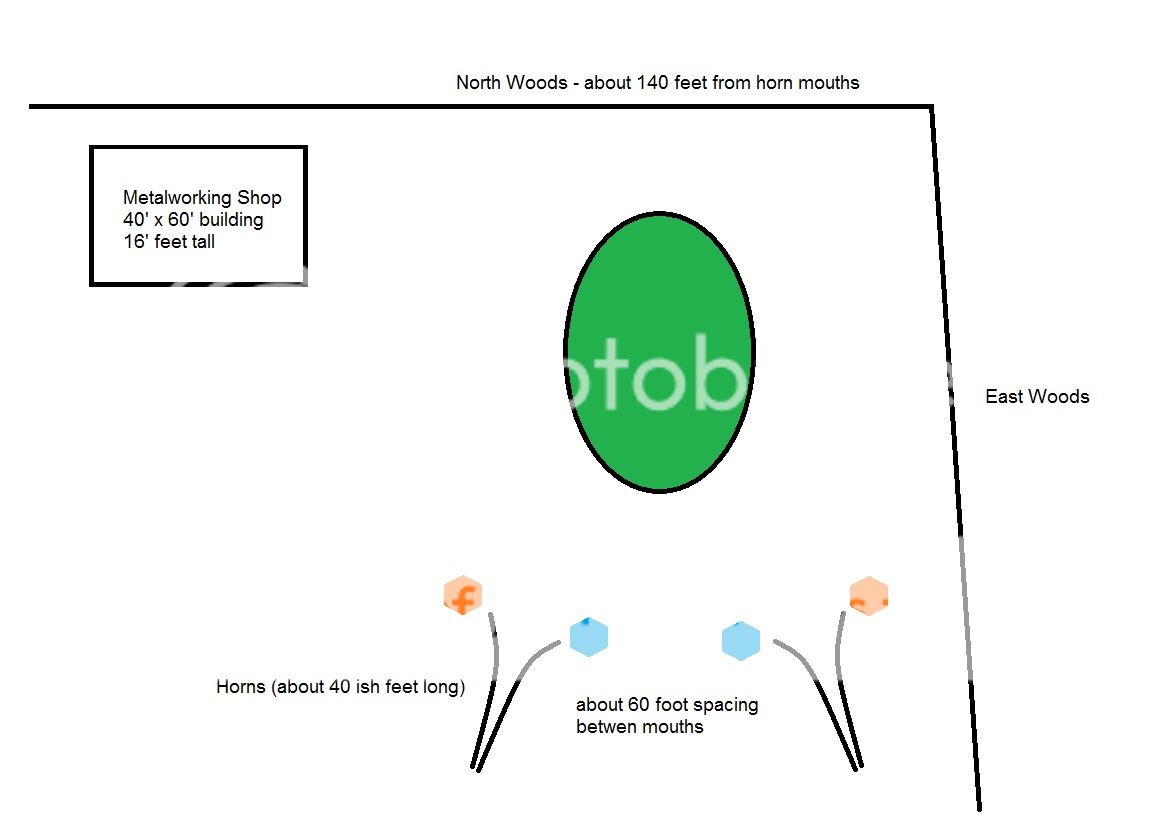
1)The main purpose of this sound system, is for me to place a hot tub somewhere in the green area (above ground, or perhaps in-ground - haven't decided yet) - to relax in the tub and enjoy some music with my family (reasonable listening levels).
2)The second purpose of the system is to entertain guests (aka party) assume no more than 100 people (aka elevated listening levels). I have no idea if all 100 people will go out into the green area, and dance. Most of my friends are mechanical engineers, nuclear engineers, and physicists. I'm considered the grease-monkey of the group. Likely there will not be much dancing - unless people bring their teenage kids. . . . I may end up installing a few telephone poles - to hoist up DJ-style lights. The DJ-lights are NOT part of the initial design, and "might" come later.
3)So really, the only listening area is in the green. Please, feel free to make adjustment/recommendations for the horn layout. The 60 foot spacing was intended to get stereo separation down low. It is necessary, I don't know. . .
4)Not shown is a small shed that will be between the rear of the horns. The shed will receive a dedicated 240 volt, 200 amp service, and house the electronics (should be more than enough power).
The photos below show a hot tub sub using two $5 "buyout" 10" woofers, it put out plenty of level down to 25 Hz with a Technics receiver set at "11 oclock", powering the patio, kitchen, and living room speakers and subs. When I first tested the "Tub Sub" and patio speaker system, turned up the receiver to just under clipping, the SPL was about conversational level at my nearest neighbor to the south, 900 feet away. It was rock and roll level in the 60 foot fenced patio area.
2) Having spent some time around mechanical engineers, nuclear engineers, and physicists at parties in Los Alamos, when they inquired into my line of work (speaker design, live and recorded music production), for the most part they yawned, and continued to talk among themselves as far away from any source of music or party noise as they could get.
Rather than installing a few telephone poles to hoist up DJ-style lights, why not do like DJs and live production people do, use aluminum truss and crank lifts. Save you a lot of money, and can be used for pulling engines, lifting stuff out of the way in the warehouse and stuff like that the other 350 days of the year you are not throwing parties.
3) As JAG has already mentioned, with the listening area only comprising an approximate 6 dB variation in SPL, elevation won't be critical.
Generally, most music that has been recorded by intelligent life forms has LF signal below 100 Hz mixed dead center. Putting your subs at some arbitrary distance off center will cause the dead center image to lobe anywhere but down power alley.
If you want to use a pair of subs, the best location for the top cabinets would either be directly above, below, or inside them.
Making the sub compression chamber/speaker boxes separate from the horns would allow their use as sealed boxes in different configurations appropriate for various events, or in your shop to provide a bass line to your grinding. They can be secured in place with over-center clamps or ratchet straps, weatherproof neoprene gaskets between the compression chamber and horn throat entrance. Back in my early sound days, I used horn compression chamber boxes apart from large horns in many venues that were too small to fit them, the horns remained in the truck, the show still rocked, just had to decrease the upper crossover outputs to match the lesser sensitivity.
5) You could run a sound system at the distance you propose at a SPL that would make most anyone reach for hearing protection using a pair of 20 amp 120VAC circuits, if you are using anything but tube amplification.
Art
Attachments
Last edited:
Maybe one side of the horn could be the ground. As long as you have a slight slope, you should not have to worry about moisture at the driver section. Just put footers for the vertical sides. Not like you were really going to move the things.
I admit I would do it if given the space.
I admit I would do it if given the space.
To keep the bears from the woods from using it as a crapperArt, wondering why you put a cover on the horse trough?
The cover keeps the hot tub's heat contained, and the coal dust out, though since I sold the property including the tub and all the built in speakers, have not checked in since before the hurricane went by my new digs in Florida.
Different having neighbors close enough where their tree branches fall on your house...
Art
If you really want to know you can simulate it. This thread is about horns, so I'll stick to horns here. Use Leonard Audio TL.app and sim a horn. Then put a hole in it somewhere along the flare and see what happens. Maybe if I have time to waste I'll do this later. [snip lots of words about airtight containers]
I would assume that a hole near the throat would be pretty bad, as the horn requires a strong flare to work properly, leaks are a bad idea. Moving towards the mouth it's probably less important.
This sim is nice info, but the conclusion is not relevant to your earlier statement (that I was responding to). You have made two points that do not seem to match up:
1) "I've daydreamed about turning one of them (shipping containers) into a sub, but I would never do it. Metal rots, so there's a very short shelf life on a used shipping container if you want it to stay airtight."
2) "This thread is about horns, so I'll stick to horns here."
...the (non airtight) shipping container would be the shell AROUND the horn (my suggestion was to "weld the frames of the horn mouths directly to the interior of the containers").
In that situation, as I pointed out in post 159, it wouldn't matter whether the container is airtight. Rusty or not, the shipping container would have nothing to do with a leak at the horn throat.
I'm confident that you or the OP would be able to build a horn properly and airtight. Especially the OP. Because submarines
The doors and door seals are not an issue, they would be open or completely removed to make the mouth. it's the rest of the container that's a problem, and due to it's size and construction, it's a huge problem to get it up to speaker enclosure standards.
Again, I'd suggest (in general, for anyone crazy enough to do this) keeping the doors, to act as horn extensions. If I were to construct one myself, I'd definitely keep the doors, to prevent local animals (such as these unfriendly critters) from nesting in the horn.
https://en.wikipedia.org/wiki/Eastern_brown_snake
Attachments
This sim is nice info, but the conclusion is not relevant to your earlier statement (that I was responding to). You have made two points that do not seem to match up:
1) "I've daydreamed about turning one of them (shipping containers) into a sub, but I would never do it. Metal rots, so there's a very short shelf life on a used shipping container if you want it to stay airtight."
2) "This thread is about horns, so I'll stick to horns here."
...the (non airtight) shipping container would be the shell AROUND the horn (my suggestion was to "weld the frames of the horn mouths directly to the interior of the containers").
In that situation, as I pointed out in post 159, it wouldn't matter whether the container is airtight. Rusty or not, the shipping container would have nothing to do with a leak at the horn throat.
I'm confident that you or the OP would be able to build a horn properly and airtight. Especially the OP. Because submarines
If I was going to do this the container would be the horn, I wouldn't put a horn inside a container. The container walls would be the horn walls. I'm a frugal kind of guy, the only reason I ever even thought about using a container is because it's already an enclosure and it's already in my back yard.
Just to be clear, I wouldn't make it anything like your picture, I would make it a folded horn similar to the Matterhorn.
To use a shipping container only as a shelter for a horn is something I would never do, I'd rather make modular horns out of wood and store them in my living room.
Last edited:
Stackable maritime shipping containers - specifically the ones that are stacked a dozen tall on cargo ships - are very tough, and very rigid units. They also have excellent door seals. I suspect they are quite expensive on the private market though. . .
Around $2k each in Australia (delivery is more), can be a bit less in the USA. Doesn't seem like much, given to the scale of the project. Of course, it's not that relevant for you, if you're not allowed to have them
Again, to skip all the delightful theoretical flirting and go to basics: here is a similar project that worked well, is similar to your initial concept, looks like (relatively speaking) quite an easy build, and there is some personal, practical knowledge in the discussion. If you made something to this scale, then made it permanent with a concrete shell, you'd be pretty set, and you could probably have it done in a couple of weeks.
RE: Burning Man Sound? - Don Bunce - High Efficiency Speaker Asylum
If I was in your enviable position, I'd extend the horn mouth (in the horizontal plane) with wings, probably gabion walls, I think they look good, and I'd partially bury the horn, for a Hobbiton aesthetic.
Attachments
Last edited:
If I was going to do this the container would be the horn, I wouldn't put a horn inside a container. The container walls would be the horn walls. I'm a frugal kind of guy, the only reason I ever even thought about using a container is because it's already an enclosure and it's already in my back yard.
Just to be clear, I wouldn't make it anything like your picture, I would make it a folded horn similar to the Matterhorn.
OK, thanks - I wouldn't have realised without that clarification.
I was describing a possible method whereby the OP's might construct what he asked for in his opening posts: some "bucket list" "reinforced concrete straight horns" "not constrained by space", using multiple tons of material.
It simply didn't occur to me that your argument against using shipping containers was based upon visualising a different system - a "frugal" folded horn with steel walls 1.6mm thick.
Again, to skip all the delightful theoretical flirting and go to basics: here is a similar project that worked well, is similar to your initial concept, looks like (relatively speaking) quite an easy build, and there is some personal, practical knowledge in the discussion. If you made something to this scale, then made it permanent with a concrete shell, you'd be pretty set, and you could probably have it done in a couple of weeks.
A quick skim of that thread suggests that the guy that designed and built it had absolutely no idea at all what he was doing. He suggests it can't be simulated. He is very wrong, and i would bet if simulated it would be a terrible design. He ported the rear chamber into the horn without having any idea what effect it would have and it sounds like the rest of his design decisions were made with the same wild abandon.
In my experience projects like this designed by people like that rarely turn out well regardless of the rave reviews they give their own incompetence.
And true to form, that thread faded to black in 2013 with no results from Gwen. Another pipe dream up in smoke. This is how all of these ambitious project discussions go - a dreamer is convinced they are going to make a system well beyond the realm of feasibility and then just disappears without making anything.
I discuss projects like this for intellectual entertainment but I don't expect anything to ever come of it. Here's hoping this one turns out different - there's a first time for everything.
A quick skim of that thread suggests that the guy that designed and built it had absolutely no idea at all what he was doing. He suggests it can't be simulated. He is very wrong, and i would bet if simulated it would be a terrible design.
Maybe you missed the builder's line "There were fewer sim tools then". I believe the horn was built, enjoyed, then set on fire, well before the 2013 thread.
...but he may still be happy to answer questions about it
And true to form, that thread faded to black in 2013 with no results from Gwen. Another pipe dream up in smoke. This is how all of these ambitious project discussions go - a dreamer is convinced they are going to make a system well beyond the realm of feasibility and then just disappears without making anything.
Did you seriously not see the photo of the actual horn, and the bits where GregB describes how it measured and sounded?
It was a real build (Gwen may have been just a dreamer*, but who cares? The original horn was real and worked). Yes, it did go up in smoke, but not figuratively!
*or maybe Gwen did continue with the project, but moved to a German speaking forum for any further help.
Last edited:
- Status
- This old topic is closed. If you want to reopen this topic, contact a moderator using the "Report Post" button.
- Home
- Loudspeakers
- Subwoofers
- Concrete Bass Horn Design Question
